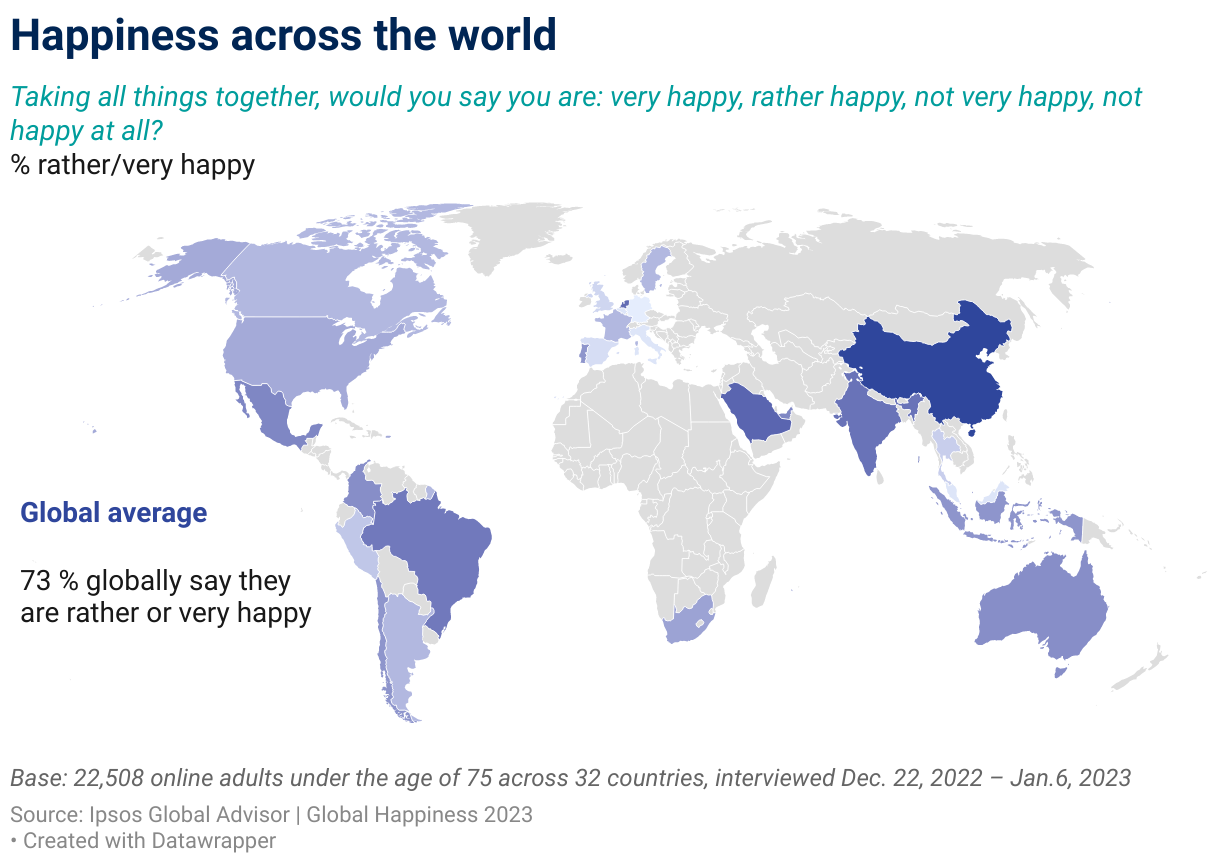
On average, nearly three in four (73%) adults across 32 countries describe themselves as happy, according to the results of a new Ipsos survey. Of all the countries surveyed, those with the highest percentage of happy citizens are China, Saudi Arabia, and the Netherlands. These are the findings of a 32-country Ipsos survey conducted December 22, 2022 - January 6, 2023, among 22,508 adults via Ipsos’s Global Advisor online survey platform.
On average across the 32 countries surveyed, 73% say they are very or rather happy. Among those countries, respondents from China (91%), Saudi Arabia (86%), the Netherlands (85%), India (84%), and Brazil (83%) report the highest level of happiness, while respondents from Hungary (50%), South Korea (57%) and Poland (58%) report the lowest.
The overall increase masks very different trends across regions: while the percentage of self-reported happy people has risen sharply across Latin America, it has taken a tumble in many Western countries. Year-over-year changes range from 26-point gains in Colombia and Argentina to a 13-point drop in Great Britain. On average, happiness in middle-income countries (as defined by the World Bank) saw a more obvious increase than it did in high-income countries. The average happiness level of middle-income countries has surpassed that of high-income countries for the first time since Ipsos started tracking them in 2011.
Among all the aspects of their life, people tend to be most satisfied with their relationships—with their children, partner, relatives, friends, co-workers, and with nature—and with knowledge-related areas such as their level of education and their access to information. On average globally, people tend to be least satisfied with the economic, social situation of their country, their own finances and their physical activity.
本时文内容由奇速英语国际教育研究院原创编写,未经书面授权,禁止复制和任何商业用途,版权所有,侵权必究!(作者投稿及时文阅读定制请联系微信:18980471698)1.Which is the right order of countries with higher percentage of happy citizens?
A South Korea, Hungary, Poland, the Netherlands
B Hungary, South Korea, the Netherlands, Brazil
C Saudi Arabia, China , Hungary, Brazil
D Saudi Arabia, India, Poland, Hungary
解析:选D。D细节理解题。根据第二段“China (91%), Saudi Arabia (86%), the Netherlands (85%), India (84%), and Brazil (83%)”“Hungary (50%), South Korea (57%) and Poland (58%)”可知公民幸福感指数从高到低依次排序为:China (91%), Saudi Arabia (86%), the Netherlands (85%), India (84%), and Brazil (83%), Poland (58%), South Korea (57%) and Hungary (50%)。故选D。
2.What does the underlined word “tumble” mean?
A Sharp rise.
B Sudden fall.
C Slow increase.
D Steady decrease.
解析:选B。B词义猜测题。根据划线部分前文关键词“different trends”“while”“has risen sharply”可知,生活幸福指数在拉丁美洲“飙升”,并结合后面的“a 13-point drop in Great Britain”可知,生活幸福感指数在许多西方国家有所“下降”。故选B。
3.What can be inferred from the last paragraph?
A Many people are content with their physical activity.
B Happy people are often optimistic about relationships.
C Very few people are satisfied with their level of education.
D Unhappy people usually has someone to turn to for support.
解析:选B。B推理判断题。根据最后一段内容可知,人们最满意的往往是他们与孩子、配偶、亲戚、朋友、同事和自然之间的关系,以及与知识相关的领域,如他们的教育水平和获取信息的渠道。人们往往对自己国家的经济、社会状况、自己的财务状况以及体育活动最不满意。由此可知,幸福的人通常对人际关系持乐观态度。故选B。
4.What is the purpose of the text?
A To explain a phenomenon.
B To inform the public of an event.
C To argue over a social issue.
D To illustrate an investigation.
解析:选D。D推理判断题。根据全文内容可知,本文是一篇说明文,对益普索集团发布的一份有关全球幸福指数的调查报告进行了说明。故选D。